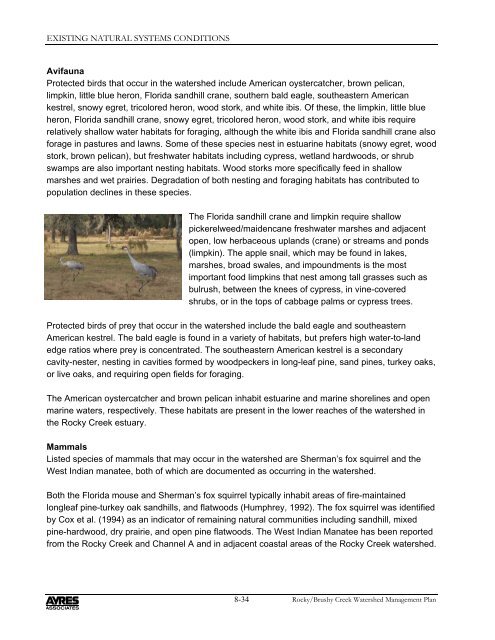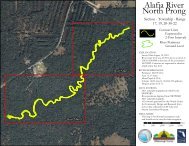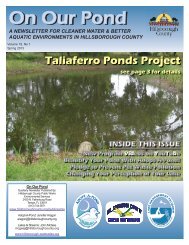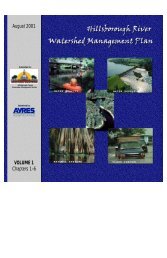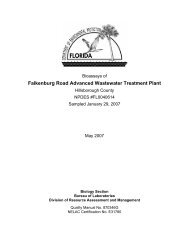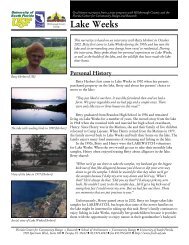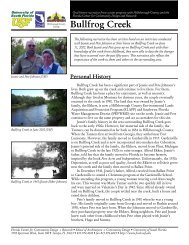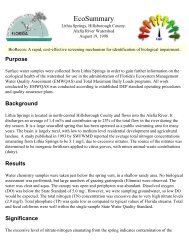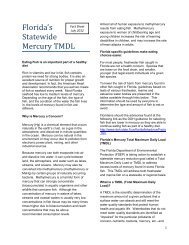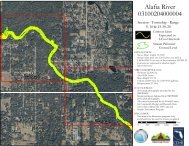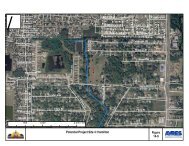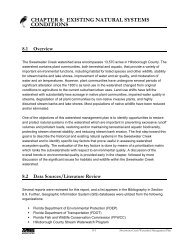Rocky Brushy Creek Watershed Mgmt. Plan (2007) -- Part 2
Rocky Brushy Creek Watershed Mgmt. Plan (2007) -- Part 2
Rocky Brushy Creek Watershed Mgmt. Plan (2007) -- Part 2
Create successful ePaper yourself
Turn your PDF publications into a flip-book with our unique Google optimized e-Paper software.
EXISTING NATURAL SYSTEMS CONDITIONSAvifaunaProtected birds that occur in the watershed include American oystercatcher, brown pelican,limpkin, little blue heron, Florida sandhill crane, southern bald eagle, southeastern Americankestrel, snowy egret, tricolored heron, wood stork, and white ibis. Of these, the limpkin, little blueheron, Florida sandhill crane, snowy egret, tricolored heron, wood stork, and white ibis requirerelatively shallow water habitats for foraging, although the white ibis and Florida sandhill crane alsoforage in pastures and lawns. Some of these species nest in estuarine habitats (snowy egret, woodstork, brown pelican), but freshwater habitats including cypress, wetland hardwoods, or shrubswamps are also important nesting habitats. Wood storks more specifically feed in shallowmarshes and wet prairies. Degradation of both nesting and foraging habitats has contributed topopulation declines in these species.The Florida sandhill crane and limpkin require shallowpickerelweed/maidencane freshwater marshes and adjacentopen, low herbaceous uplands (crane) or streams and ponds(limpkin). The apple snail, which may be found in lakes,marshes, broad swales, and impoundments is the mostimportant food limpkins that nest among tall grasses such asbulrush, between the knees of cypress, in vine-coveredshrubs, or in the tops of cabbage palms or cypress trees.Protected birds of prey that occur in the watershed include the bald eagle and southeasternAmerican kestrel. The bald eagle is found in a variety of habitats, but prefers high water-to-landedge ratios where prey is concentrated. The southeastern American kestrel is a secondarycavity-nester, nesting in cavities formed by woodpeckers in long-leaf pine, sand pines, turkey oaks,or live oaks, and requiring open fields for foraging.The American oystercatcher and brown pelican inhabit estuarine and marine shorelines and openmarine waters, respectively. These habitats are present in the lower reaches of the watershed inthe <strong>Rocky</strong> <strong>Creek</strong> estuary.MammalsListed species of mammals that may occur in the watershed are Sherman’s fox squirrel and theWest Indian manatee, both of which are documented as occurring in the watershed.Both the Florida mouse and Sherman’s fox squirrel typically inhabit areas of fire-maintainedlongleaf pine-turkey oak sandhills, and flatwoods (Humphrey, 1992). The fox squirrel was identifiedby Cox et al. (1994) as an indicator of remaining natural communities including sandhill, mixedpine-hardwood, dry prairie, and open pine flatwoods. The West Indian Manatee has been reportedfrom the <strong>Rocky</strong> <strong>Creek</strong> and Channel A and in adjacent coastal areas of the <strong>Rocky</strong> <strong>Creek</strong> watershed.8-34<strong>Rocky</strong>/<strong>Brushy</strong> <strong>Creek</strong> <strong>Watershed</strong> Management <strong>Plan</strong>


